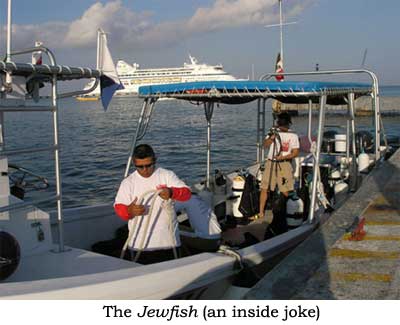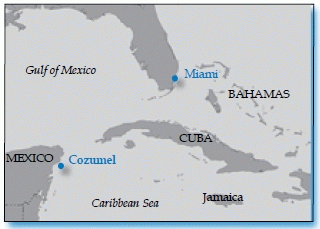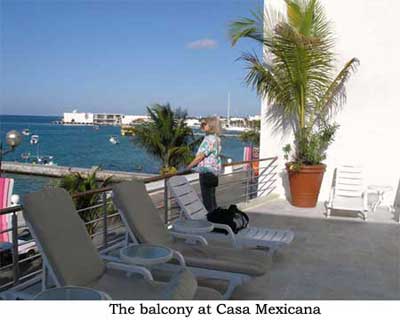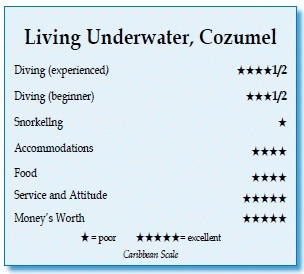Living Underwater, Cozumel, MexicoContents of this Issue: Living Underwater, Cozumel, Mexico Hunting Lionfish, Then Eating Them Nautilus Swell, British Columbia The Trouble with Artificial Reefs Death Due to Poor Gear Maintenance What to Do with Smoking Divers How Smokers Really Ruin Their Diving Why You Should Skip Trip Insurance How Divers Can Give Back: Part II That Hovering Fish May Want a Massage Nautilus Lifeline: User Error or Gear Malfunction? Dolphins Should Be Considered “Non-Human Humans” Editorial Office: Ben Davison Publisher and Editor Undercurrent 3020 Bridgeway, Suite 102 Sausalito, CA 94965 back to my first love, who still looks fantastic from the April, 2012 issue of Undercurrent
Dear Fellow Diver: I like to dive the Caribbean: 10 different countries so far, and multiple locations in half of those. However, Cozumel is my first and best love. We have a long history together. In January, I visited the island after nearly a seven-year separation, largely caused by what Hurricane Wilma had done in 2005. Wilma, the largest storm ever measured in the tropical Atlantic, did serious damage to the island and its reefs. While the island's topside, a major cruise ship destination, recovered quickly, developers can't speed the natural recovery of the coral oasis. Nevertheless, I was pleased to see underwater Cozumel, famed for its formations, currents, visibility and marine park status, looking good upon my return. On my second day of diving, the fast boat from Living Underwater headed north of town -- not to the marine park, but probably where the snapper I ate the night before was caught. It's the location of Eagle Ray Wall, which for a winter month or two is a go-to spot for its migrating namesakes. During the short ride, the sun came out and stayed out, as it did most of the week, giving better color underwater. Winter weather is a concern, as a north wind (called a "noreaster" back home) could lock a diver on shore for a couple of days. I lucked out: Daytime temperatures were in the low 80s, and water temperatures were 80 to 81 degrees. Perfecto.
Jeremy is a Minnesota expat who has lived in Cozumel for 12 years and owned Living Underwater for eight. He offers a fast boat with twin 115-hp engines, a competent crew of two on every dive, 120 cu.-in. tanks, and premium service. The evening I arrived, Jeremy met me at my hotel and took my equipment; the next time I handled it was when I left. Towels, bottled water and parkas for the chilly were ready after each dive, and Jeremy provided snacks during the 90-minute surface intervals, usually spent at Playa Palancar. Jeremy is now a Mexican citizen, but he showed his gringo side each day at 7:40 a.m. when his boat, the Jewfish, was exactly on time at the pier across the street from my hotel, and he made clear that he expected the same from me. I was back at Casa Mexicana by 1:30 p.m., ready to kick back or explore the back streets of Cozumel. (Some may regard "Jewfish" as an odd name for boat. Jeremy is Jewish, so it it's an inside joke. I told him it has been called the Goliath grouper for a decade; he replied, "Not in Cozumel.") Casa Mexicana is a first-class hotel right in town. My room was on the fourth floor, lacking an ocean view but otherwise fine. I put six Leon Negras in the mini-fridge and sat on the second- floor terrace, near the pool and tiny bar, to gaze at the ocean. There are plenty of other hotel options near the zócalo, some very inexpensive. I prefer being in town, rather than the highrises south and north of town. On my one non-diving day, I rented a cheap motor scooter and headed for the reserve at the southern tip of the island. (Our scooter rental involved a guy at a booth on the street, set up for cruise shippers, who asked twice the going rate of $20 but was easily bargained down.) In the lagoon, we saw saltwater crocodiles and a variety of spectacular birds. There's still some dead mangrove cover -- a Wilma graveyard -- but a naturalist told us the birds are steadily coming back. It sure seemed so.
Jeremy is a keen observer. I use a magnifier to view macro life, and he accommodated my interest in the small and unusual. On San Francisco Wall, he found two spectacularly painted, half-inch elysia sea slugs that I would surely have overlooked. In Colombia Shallows, he tied a piece of algae to a string and jigged it in front of a hole until a splendid toadfish, a Cozumel endemic, snapped it up. A disappointment for that carnivore but a chuckle for five divers. As my computer went into deco status, my buddy and I signaled to Jeremy we were going up, and he put up a float before he and two other divers headed on. As I left the top of the reef, I saw several big almaco jacks in the blue water. After a six-minute safety stop, I did a 360-turn for safety in Cozumel's heavy traffic. The boat crew of Francisco and Ricardo was always nearby and ready to help lift gear through a door opening on the side of the boat, and they seemed to have it set up for the next dive (or ready to wash) by the time the last diver came up the ladder. It wasn't the first time I surfaced "early," which was usually after an hour. I told Jeremy that because my partner and I are senior citizens, we dive conservatively and would appreciate a slightly different profile. His response was direct: Surface when you feel you should because the float will be up and the boat will be there. There were two to four other divers on the boat each day, mostly experienced Canadians and Americans who regularly went into deco. It's an operation for experienced and confident divers. I would recommend that beginning divers ask in advance to be part of a novice dive group. On my last evening, I ate at Casa Denis. My first meal on Cozumel was here in 1986, and the place is still attached to the family home, just steps from the central plaza. After snapper and a couple of beers, I visited with the waiters there and then moved on to another bar. Everyone I talked with, both here and in the state of Campeche a few days later, blamed the global recession for the business slowdown. But some also noted the unfounded fears in the U.S. of widespread crime in Mexico. In reality, the drug cartel violence is confined to a few areas, mostly near the U.S. border. Cozumel and all of the Yucatán are safe for tourists. When I asked for a key to lock my room at a little inn on the mainland, near Guatemala, the owner said not to bother locking it. I won't try that back home. -- M.A.
|

I want to get all the stories! Tell me how I can become an Undercurrent Online Member and get online access to all the articles of Undercurrent as well as thousands of first hand reports on dive operations world-wide
| Home | Online Members Area | My Account |
Login
|
Join
|
| Travel Index |
Dive Resort & Liveaboard Reviews
|
Featured Reports
|
Recent
Issues
|
Back Issues
|
|
Dive Gear
Index
|
Health/Safety Index
|
Environment & Misc.
Index
|
Seasonal Planner
|
Blogs
|
Free Articles
|
Book Picks
|
News
|
|
Special Offers
|
RSS
|
FAQ
|
About Us
|
Contact Us
|
Links
|
3020 Bridgeway, Ste 102, Sausalito, Ca 94965
All rights reserved.

 I backrolled
into a modest current,
headed to the
top of the wall,
then eased along at
85 feet. The main
show is in the blue,
but I left that watch to Jeremy Anschel, the owner of
Living Underwater, and checked out the
nooks and crannies on the wall. Drifting
ahead of the pack, I startled a spotted
moray, which rushed into a hole and
disappeared in a swirling cloud of sand.
When the water cleared, a spiny lobster
sat calmly in the hole, and the chastened
moray peered out six feet away. I looked
at Jeremy, who was staring intently into
the blue. A barely visible squadron of
eagle rays moved out of sight. We stayed
put for a couple minutes (I was glad I added two pounds of lead for this dive).
As a bicolor damsel, defending its algae
farm, nipped at my legs and arms, seven
eagles, flying in formation, banked right
by us, giving a perfect show. We saw another squadron later, and several individual
rays. One cruised just a meter over my buddy, who didn't see it until
it passed over and startled her, to the amusement of the other two divers with
us. I passed well above a huge school of yellowtail snappers. Because it's a
food fish, I was surprised to see so many here in the northern fishing zone.
After nearly an hour, my computer was at the deco line, and I started up in
blue water. At the long safety stop, I watched a few houndfish that seemed to be
chasing after nothing, while my partner studied comb jellies, which seem to favor
a 20-foot depth and provide a sideshow for the long Cozumel hang time.
I backrolled
into a modest current,
headed to the
top of the wall,
then eased along at
85 feet. The main
show is in the blue,
but I left that watch to Jeremy Anschel, the owner of
Living Underwater, and checked out the
nooks and crannies on the wall. Drifting
ahead of the pack, I startled a spotted
moray, which rushed into a hole and
disappeared in a swirling cloud of sand.
When the water cleared, a spiny lobster
sat calmly in the hole, and the chastened
moray peered out six feet away. I looked
at Jeremy, who was staring intently into
the blue. A barely visible squadron of
eagle rays moved out of sight. We stayed
put for a couple minutes (I was glad I added two pounds of lead for this dive).
As a bicolor damsel, defending its algae
farm, nipped at my legs and arms, seven
eagles, flying in formation, banked right
by us, giving a perfect show. We saw another squadron later, and several individual
rays. One cruised just a meter over my buddy, who didn't see it until
it passed over and startled her, to the amusement of the other two divers with
us. I passed well above a huge school of yellowtail snappers. Because it's a
food fish, I was surprised to see so many here in the northern fishing zone.
After nearly an hour, my computer was at the deco line, and I started up in
blue water. At the long safety stop, I watched a few houndfish that seemed to be
chasing after nothing, while my partner studied comb jellies, which seem to favor
a 20-foot depth and provide a sideshow for the long Cozumel hang time. Cozumel reefs look good. My partner and I kept notes on post-Wilma differences.
Soft corals and some sponges were fewer or smaller as they regrow. Some
fish species may be sparser, especially larger parrotfish. We dived Colombia
Shallows one morning, because Jeremy had two newbies on the boat. The sand bottom
at 25 feet was a killing field of acropora pieces, mostly staghorn. For the
most part, the reefs and fish life are vibrant, taking into account that live
coral cover has been reduced here and all over the Caribbean because of global
ocean degradation. Jeremy thinks the invasive lionfish has already done more damage
to the reef ecology than Wilma. But the formations at Palancar, Colombia and
Punta Sur are as dramatic as ever, and a big reason for the flotilla of dive
boats headed out each morning.
Cozumel reefs look good. My partner and I kept notes on post-Wilma differences.
Soft corals and some sponges were fewer or smaller as they regrow. Some
fish species may be sparser, especially larger parrotfish. We dived Colombia
Shallows one morning, because Jeremy had two newbies on the boat. The sand bottom
at 25 feet was a killing field of acropora pieces, mostly staghorn. For the
most part, the reefs and fish life are vibrant, taking into account that live
coral cover has been reduced here and all over the Caribbean because of global
ocean degradation. Jeremy thinks the invasive lionfish has already done more damage
to the reef ecology than Wilma. But the formations at Palancar, Colombia and
Punta Sur are as dramatic as ever, and a big reason for the flotilla of dive
boats headed out each morning. Cozumel above water is a tale of two cities. Along the glitzy malecón, dozens
of shops post hawkers out front, promising overpriced jewelry and 60 percent
discounts on Viagra. I counted two to seven
cruise ships docking each day but even on the high
days, the hawkers looked forlorn and the shops
were sparsely populated. Just two blocks from the
water, the other Cozumel is a lot more fun. I ate
lunch and dinner at a different spot each day, and
paid $5 for lunch, $10 for a full dinner, half as
much as on the malecón. Sabores, a lunch spot with
a chalkboard menu, served up great soup and low
prices in a backyard garden. Bahia del Caribe, a
restaurant owned by the fishermen's cooperative,
offered fantastic lionfish cooked to order, and a
bunch of sides, including two ceviches of lionfish
and octopus. The clientele was mostly locals,
although we provided menu interpretation for some
Dutch tourists whose English was better than their
Spanish. When I mentioned this place on the boat,
divers staying at the pricey hotels south of town
turned green with envy. Why don't more divers get
off Cruise Ship Lane?
Cozumel above water is a tale of two cities. Along the glitzy malecón, dozens
of shops post hawkers out front, promising overpriced jewelry and 60 percent
discounts on Viagra. I counted two to seven
cruise ships docking each day but even on the high
days, the hawkers looked forlorn and the shops
were sparsely populated. Just two blocks from the
water, the other Cozumel is a lot more fun. I ate
lunch and dinner at a different spot each day, and
paid $5 for lunch, $10 for a full dinner, half as
much as on the malecón. Sabores, a lunch spot with
a chalkboard menu, served up great soup and low
prices in a backyard garden. Bahia del Caribe, a
restaurant owned by the fishermen's cooperative,
offered fantastic lionfish cooked to order, and a
bunch of sides, including two ceviches of lionfish
and octopus. The clientele was mostly locals,
although we provided menu interpretation for some
Dutch tourists whose English was better than their
Spanish. When I mentioned this place on the boat,
divers staying at the pricey hotels south of town
turned green with envy. Why don't more divers get
off Cruise Ship Lane? It's nice to have a final dive be a special one, and Cedar Mountains,
at the south end of Cedar Wall, didn't disappoint. I saw turtles on most
dives, but this was turtle soup. As I got down to the reef, a curious juvenile
hawksbill came within 10 feet of me within moments before heading to the surface for air. I cruised over
the "mountains" of coral mounds, with
a fast current up top and more leisurely
below. In a low spot, I slowed
down to entice a mantis shrimp out of
its hole, as a queen angel circled
me. At another low spot, I stopped to
watch Jeremy kill a lionfish. After he
removed it from the tiny spear, two
ocean triggerfish dashed in to gobble
the carcass. That stop cost me a patch
of hydroid stings as I put a hand in
the sand. My buddy, a naturalist by
profession, thinks hydroids have proliferated
on some Cozumel reefs. That
didn't ease the itch I had the next
day. As we came up one hill, I was
lucky to spot a well-camouflaged,
bright green peacock flounder on an
algae patch. The sixth turtle I saw on
this dive was a large one just off the
reef, with gray and French angels busily picking tidbits off its shell. Later
Jeremy told me that I misinterpreted this -- they were nibbling scraps left
behind by the feeding turtle.
It's nice to have a final dive be a special one, and Cedar Mountains,
at the south end of Cedar Wall, didn't disappoint. I saw turtles on most
dives, but this was turtle soup. As I got down to the reef, a curious juvenile
hawksbill came within 10 feet of me within moments before heading to the surface for air. I cruised over
the "mountains" of coral mounds, with
a fast current up top and more leisurely
below. In a low spot, I slowed
down to entice a mantis shrimp out of
its hole, as a queen angel circled
me. At another low spot, I stopped to
watch Jeremy kill a lionfish. After he
removed it from the tiny spear, two
ocean triggerfish dashed in to gobble
the carcass. That stop cost me a patch
of hydroid stings as I put a hand in
the sand. My buddy, a naturalist by
profession, thinks hydroids have proliferated
on some Cozumel reefs. That
didn't ease the itch I had the next
day. As we came up one hill, I was
lucky to spot a well-camouflaged,
bright green peacock flounder on an
algae patch. The sixth turtle I saw on
this dive was a large one just off the
reef, with gray and French angels busily picking tidbits off its shell. Later
Jeremy told me that I misinterpreted this -- they were nibbling scraps left
behind by the feeding turtle. Divers Compass: Cozumel is an easy and relatively inexpensive
destination all around . . . I flew on Delta one morning, connecting
through its Atlanta hub, and was on the island before 1
p.m . . . Living Underwater charges $87 for a two-tank dive (discounts
for groups of four divers; nitrox is available at extra
charge) and you can scan and email your c-card along with their
litigation waiver in advance . . . I booked a double room at Casa
Mexicana through Orbitz.com for $91 per night, including tax, with
an excellent breakfast included . . . Most visitors use ATMs and
credit cards, but I hate bank fees, so I carried a good bit of U.S. dollars and
changed them at a good exchange rate at convenient outlets (don't change money at
the Cozumel airport) . . . I took the ferry ($12) to Playa del Carmen, a cheap
place to stay and eat although crowded with visitors, and rented a car through
Orbitz to drive five hours south to visit a few Mayan sites and see another side
of Mexico . . . Websites: Living Underwater -
Divers Compass: Cozumel is an easy and relatively inexpensive
destination all around . . . I flew on Delta one morning, connecting
through its Atlanta hub, and was on the island before 1
p.m . . . Living Underwater charges $87 for a two-tank dive (discounts
for groups of four divers; nitrox is available at extra
charge) and you can scan and email your c-card along with their
litigation waiver in advance . . . I booked a double room at Casa
Mexicana through Orbitz.com for $91 per night, including tax, with
an excellent breakfast included . . . Most visitors use ATMs and
credit cards, but I hate bank fees, so I carried a good bit of U.S. dollars and
changed them at a good exchange rate at convenient outlets (don't change money at
the Cozumel airport) . . . I took the ferry ($12) to Playa del Carmen, a cheap
place to stay and eat although crowded with visitors, and rented a car through
Orbitz to drive five hours south to visit a few Mayan sites and see another side
of Mexico . . . Websites: Living Underwater - 